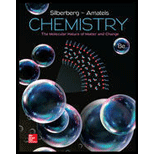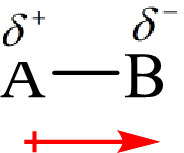
Chemistry: The Molecular Nature of Matter and Change
8th Edition
ISBN: 9781259631757
Author: Martin Silberberg Dr., Patricia Amateis Professor
Publisher: McGraw-Hill Education
expand_more
expand_more
format_list_bulleted
Concept explainers
Question
Chapter 10, Problem 10.91P
Interpretation Introduction
Interpretation:
The shape of the molecule
Concept introduction:
The dipole moment arises when there is a separation of charges between two ions or atoms involved in the bond. The dipole moment is a vector quantity and its direction towards the most electronegative atom.
The direction of the dipole moment is represented as follows:

The polar and non-polar molecule can be identified on the basis of the net dipole moment. Polar molecules have non zero value of net dipole moment and the nonpolar molecules have zero net dipole moment.
Expert Solution & Answer
Want to see the full answer?
Check out a sample textbook solution
Students have asked these similar questions
Draw the Zaitsev product famed when 2,3-dimethylpentan-3-of undergoes an El dehydration.
CH₂
E1
OH
H₁PO₁
Select Draw Templates More
QQQ
+H₂O
Complete the clean-pushing mechanism for the given ether synthesia from propanol in concentrated sulfurica140°C
by adding any mining aloms, bands, charges, nonbonding electron pairs, and curved arrows. Draw hydrogen bonded to
cayan, when applicable.
ore 11,0
HPC
Step 1: Draw curved arrows
Step 2: Complete the intend
carved
Q2Q
56
QQQ
Step 3: Complete the intermediate and add curved
Step 4: Modify the structures to draw the
QQQ
QQQ
6. In an experiment the following replicate set of volume
measurements (cm3) was recorded:
(25.35, 25.80, 25.28, 25.50, 25.45, 25.43)
A. Calculate the mean of the raw data.
B. Using the rejection quotient (Q-test) reject any
questionable results.
C. Recalculate the mean and compare it with the value
obtained in 2(a).
Chapter 10 Solutions
Chemistry: The Molecular Nature of Matter and Change
Ch. 10.1 - Write a Lewis structure for
H2S;
;
SOCl2.
Ch. 10.1 - Prob. 10.1BFPCh. 10.1 - Prob. 10.2AFPCh. 10.1 - Prob. 10.2BFPCh. 10.1 - Prob. 10.3AFPCh. 10.1 - Prob. 10.3BFPCh. 10.1 - Prob. 10.4AFPCh. 10.1 - Prob. 10.4BFPCh. 10.1 - Write a Lewis structure with minimal formal...Ch. 10.1 - Prob. 10.5BFP
Ch. 10.2 - Prob. 10.6AFPCh. 10.2 - Prob. 10.6BFPCh. 10.2 - Prob. 10.7AFPCh. 10.2 - Prob. 10.7BFPCh. 10.2 - Prob. 10.8AFPCh. 10.2 - Prob. 10.8BFPCh. 10.3 - Prob. 10.9AFPCh. 10.3 - Prob. 10.9BFPCh. 10.3 - Prob. B10.1PCh. 10.3 - Prob. B10.2PCh. 10 - Prob. 10.1PCh. 10 - When is a resonance hybrid needed to adequately...Ch. 10 - Prob. 10.3PCh. 10 - Prob. 10.4PCh. 10 - Draw a Lewis structure for (a) SiF4; (b) SeCl2;...Ch. 10 - Draw a Lewis structure for (a) ; (b) C2F4; (c)...Ch. 10 - Prob. 10.7PCh. 10 - Prob. 10.8PCh. 10 - Prob. 10.9PCh. 10 - Draw Lewis structures of all the important...Ch. 10 - Prob. 10.11PCh. 10 - Draw Lewis structures of all the important...Ch. 10 - Prob. 10.13PCh. 10 - Prob. 10.14PCh. 10 - Draw the Lewis structure with lowest formal...Ch. 10 - Draw the Lewis structure with lowest formal...Ch. 10 - Prob. 10.17PCh. 10 - Prob. 10.18PCh. 10 - Prob. 10.19PCh. 10 - Prob. 10.20PCh. 10 - These species do not obey the octet rule. Draw a...Ch. 10 - These species do not obey the octet rule. Draw a...Ch. 10 - Molten beryllium chloride reacts with chloride ion...Ch. 10 - Prob. 10.24PCh. 10 - Prob. 10.25PCh. 10 - Phosgene is a colorless, highly toxic gas that was...Ch. 10 - If you know the formula of a molecule or ion, what...Ch. 10 - In what situation is the name of the molecular...Ch. 10 - Prob. 10.29PCh. 10 - Prob. 10.30PCh. 10 - Consider the following molecular shapes. (a) Which...Ch. 10 - Use wedge-bond perspective drawings (if necessary)...Ch. 10 - Prob. 10.33PCh. 10 - Determine the electron-group arrangement,...Ch. 10 - Determine the electron-group arrangement,...Ch. 10 - Prob. 10.36PCh. 10 - Prob. 10.37PCh. 10 - Prob. 10.38PCh. 10 - Prob. 10.39PCh. 10 - Determine the shape, ideal bond angle(s), and the...Ch. 10 - Prob. 10.41PCh. 10 - Determine the shape around each central atom in...Ch. 10 - Prob. 10.43PCh. 10 - Prob. 10.44PCh. 10 - Prob. 10.45PCh. 10 - Prob. 10.46PCh. 10 - Arrange the following ACln species in order of...Ch. 10 - State an ideal value for each of the bond angles...Ch. 10 - Prob. 10.49PCh. 10 - Prob. 10.50PCh. 10 - Prob. 10.51PCh. 10 - Prob. 10.52PCh. 10 - How can a molecule with polar covalent bonds not...Ch. 10 - Prob. 10.54PCh. 10 - Consider the molecules SCl2, F2, CS2, CF4, and...Ch. 10 - Consider the molecules BF3, PF3, BrF3, SF4, and...Ch. 10 - Prob. 10.57PCh. 10 - Prob. 10.58PCh. 10 - Prob. 10.59PCh. 10 - Prob. 10.60PCh. 10 - Prob. 10.61PCh. 10 - Prob. 10.62PCh. 10 - Prob. 10.63PCh. 10 - Prob. 10.64PCh. 10 - Prob. 10.65PCh. 10 - Prob. 10.66PCh. 10 - When SO3 gains two electrons, forms. (a) Which...Ch. 10 - The actual bond angle in NO2 is 134.3°, and in it...Ch. 10 - Prob. 10.69PCh. 10 - Propylene oxide is used to make many products,...Ch. 10 - Prob. 10.71PCh. 10 - Prob. 10.72PCh. 10 - Prob. 10.73PCh. 10 - Prob. 10.74PCh. 10 - Prob. 10.75PCh. 10 - Prob. 10.76PCh. 10 - Prob. 10.77PCh. 10 - A gaseous compound has a composition by mass of...Ch. 10 - Prob. 10.79PCh. 10 - Prob. 10.80PCh. 10 - Prob. 10.81PCh. 10 - Prob. 10.82PCh. 10 - Pure HN3 (atom sequence HNNN) is explosive. In...Ch. 10 - Prob. 10.84PCh. 10 - Prob. 10.85PCh. 10 - Oxalic acid (H2C2O4) is found in toxic...Ch. 10 - Prob. 10.87PCh. 10 - Hydrazine (N2H4) is used as a rocket fuel because...Ch. 10 - Prob. 10.89PCh. 10 - Prob. 10.90PCh. 10 - Prob. 10.91PCh. 10 - Consider the following molecular shapes:
Match...Ch. 10 - Prob. 10.93PCh. 10 - Prob. 10.94PCh. 10 - Prob. 10.95PCh. 10 - Phosphorus pentachloride, a key industrial...
Knowledge Booster
Learn more about
Need a deep-dive on the concept behind this application? Look no further. Learn more about this topic, chemistry and related others by exploring similar questions and additional content below.Similar questions
- A student proposes the transformation below in one step of an organic synthesis. There may be one or more reactants missing from the left-hand side, but there are no products missing from the right-hand side. There may also be catalysts, small inorganic reagents, and other important reaction conditions missing from the arrow. • Is the student's transformation possible? If not, check the box under the drawing area. • If the student's transformation is possible, then complete the reaction by adding any missing reactants to the left-hand side, and adding required catalysts, inorganic reagents, or other important reaction conditions above and below the arrow. • You do not need to balance the reaction, but be sure every important organic reactant or product is shown. + T G OH де OH This transformation can't be done in one step.arrow_forwardMacmillan Leaming Draw the major organic product of the reaction. 1. CH3CH2MgBr 2. H+ - G Select Draw Templates More H о QQarrow_forwardDraw the condensed structure of 3-hydroxy-2-butanone. Click anywhere to draw the first atom of your structure.arrow_forward
- Give the expected major product of reaction of 2,2-dimethylcyclopropane with each of the following reagents. 2. Reaction with dilute H₂SO, in methanol. Select Draw Templates More CHC Erase QQQ c. Reaction with dilute aqueous HBr. Select Drew Templates More Era c QQQ b. Reaction with NaOCH, in methanol. Select Draw Templates More d. Reaction with concentrated HBr. Select Draw Templates More En a QQQ e. Reaction with CH, Mg1, then H*, H₂O 1. Reaction with CH,Li, then H', H₂Oarrow_forwardWrite the systematic name of each organic molecule: structure O OH OH name X ☐arrow_forwardMacmillan Learning One of the molecules shown can be made using the Williamson ether synthesis. Identify the ether and draw the starting materials. А со C Strategy: Review the reagents, mechanism and steps of the Williamson ether synthesis. Determine which of the molecules can be made using the steps. Then analyze the two possible disconnection strategies and deduce the starting materials. Identify the superior route. Step 6: Put it all together. Complete the two-step synthesis by selecting the reagents and starting materials. C 1. 2. Answer Bank NaH NaOH NaOCH, снен, сен, он Сиси, Сне (СН), СОН (Сн, Свarrow_forward
- Write the systematic name of each organic molecule: structure CH3 O CH3-CH-CH-C-CH3 OH HV. CH3-C-CH-CH2-CH3 OH CH3 O HO—CH, CH–CH—C CH3 OH 오-오 name X G ☐arrow_forwardHI Organic Functional Groups Predicting the reactants or products of esterification What is the missing reactant in this organic reaction? HO OH H +回 + H₂O 60013 Naomi V Specifically, in the drawing area below draw the skeletal ("line") structure of R. If there is more than one reasonable answer, you can draw any one of them. If there is no reasonable answer, check the No answer box under the drawing area. No answer Click and drag to start drawing a structure. Explanation Check 1 2 #3 $ 4 2025 % ala5 'a :☐ G & 67 8 Ar K enter Accessible 9 Q W E R TY U 1 tab , S H J Karrow_forwardPlease help me with number 5 using my data and graph. I think I might have number 3 and 4 but if possible please check me. Thanks in advance!arrow_forward
- dict the major products of this organic reaction. C Explanation Check 90 + 1.0₂ 3 2. (CH3)2S Click and drag f drawing a stru © 2025 McGraw Hill LLC. All Rights Reserved. • 22 4 5 7 8 Y W E R S F H Bilarrow_forwardcan someone draw out the reaction mechanism for this reaction showing all the curly arrows and 2. Draw the GPNA molecule and identify the phenylalanine portion. 3. Draw L-phenylalanine with the correct stereochemistryarrow_forwardWhat is the reaction mechanism for this?arrow_forward
arrow_back_ios
SEE MORE QUESTIONS
arrow_forward_ios
Recommended textbooks for you
 ChemistryChemistryISBN:9781305957404Author:Steven S. Zumdahl, Susan A. Zumdahl, Donald J. DeCostePublisher:Cengage Learning
ChemistryChemistryISBN:9781305957404Author:Steven S. Zumdahl, Susan A. Zumdahl, Donald J. DeCostePublisher:Cengage Learning ChemistryChemistryISBN:9781259911156Author:Raymond Chang Dr., Jason Overby ProfessorPublisher:McGraw-Hill Education
ChemistryChemistryISBN:9781259911156Author:Raymond Chang Dr., Jason Overby ProfessorPublisher:McGraw-Hill Education Principles of Instrumental AnalysisChemistryISBN:9781305577213Author:Douglas A. Skoog, F. James Holler, Stanley R. CrouchPublisher:Cengage Learning
Principles of Instrumental AnalysisChemistryISBN:9781305577213Author:Douglas A. Skoog, F. James Holler, Stanley R. CrouchPublisher:Cengage Learning Organic ChemistryChemistryISBN:9780078021558Author:Janice Gorzynski Smith Dr.Publisher:McGraw-Hill Education
Organic ChemistryChemistryISBN:9780078021558Author:Janice Gorzynski Smith Dr.Publisher:McGraw-Hill Education Chemistry: Principles and ReactionsChemistryISBN:9781305079373Author:William L. Masterton, Cecile N. HurleyPublisher:Cengage Learning
Chemistry: Principles and ReactionsChemistryISBN:9781305079373Author:William L. Masterton, Cecile N. HurleyPublisher:Cengage Learning Elementary Principles of Chemical Processes, Bind...ChemistryISBN:9781118431221Author:Richard M. Felder, Ronald W. Rousseau, Lisa G. BullardPublisher:WILEY
Elementary Principles of Chemical Processes, Bind...ChemistryISBN:9781118431221Author:Richard M. Felder, Ronald W. Rousseau, Lisa G. BullardPublisher:WILEY

Chemistry
Chemistry
ISBN:9781305957404
Author:Steven S. Zumdahl, Susan A. Zumdahl, Donald J. DeCoste
Publisher:Cengage Learning

Chemistry
Chemistry
ISBN:9781259911156
Author:Raymond Chang Dr., Jason Overby Professor
Publisher:McGraw-Hill Education

Principles of Instrumental Analysis
Chemistry
ISBN:9781305577213
Author:Douglas A. Skoog, F. James Holler, Stanley R. Crouch
Publisher:Cengage Learning

Organic Chemistry
Chemistry
ISBN:9780078021558
Author:Janice Gorzynski Smith Dr.
Publisher:McGraw-Hill Education

Chemistry: Principles and Reactions
Chemistry
ISBN:9781305079373
Author:William L. Masterton, Cecile N. Hurley
Publisher:Cengage Learning

Elementary Principles of Chemical Processes, Bind...
Chemistry
ISBN:9781118431221
Author:Richard M. Felder, Ronald W. Rousseau, Lisa G. Bullard
Publisher:WILEY
Stoichiometry - Chemistry for Massive Creatures: Crash Course Chemistry #6; Author: Crash Course;https://www.youtube.com/watch?v=UL1jmJaUkaQ;License: Standard YouTube License, CC-BY
Bonding (Ionic, Covalent & Metallic) - GCSE Chemistry; Author: Science Shorts;https://www.youtube.com/watch?v=p9MA6Od-zBA;License: Standard YouTube License, CC-BY
General Chemistry 1A. Lecture 12. Two Theories of Bonding.; Author: UCI Open;https://www.youtube.com/watch?v=dLTlL9Z1bh0;License: CC-BY